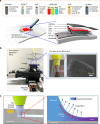Pen drawing display
- PMID: 31551492
- PMCID: PMC6760158
- DOI: 10.1038/s41467-019-12395-z
Pen drawing display
Abstract
As advancements in science and technology, such as the Internet of things, smart home systems, and automobile displays, become increasingly embedded in daily life, there is a growing demand for displays with customized sizes and shapes. This study proposes a pen drawing display technology that can realize a boardless display in any form based on the user's preferences, without the usual restrictions of conventional frame manufacturing techniques. An advantage of the pen drawing method is that the entire complex fabrication process for the display is encapsulated in a pen. The display components, light-emitting layers, and electrodes are formed using felt-tip drawing pens that contain the required solutions and light-emitting materials. The morphology and thickness of each layer is manipulated by adjusting the drawing speed, number of drawing cycles, and substrate temperature. This study is expected to usher in the upcoming era of customized displays that can reflect individual user needs.
Conflict of interest statement
The authors declare no competing interests.
Figures







References
-
- Kim T-H, et al. Full-colour quantum dot displays fabricated by transfer printing. Nat. Photonics. 2011;5:176. doi: 10.1038/nphoton.2011.12. - DOI
Publication types
LinkOut - more resources
Full Text Sources
Research Materials

